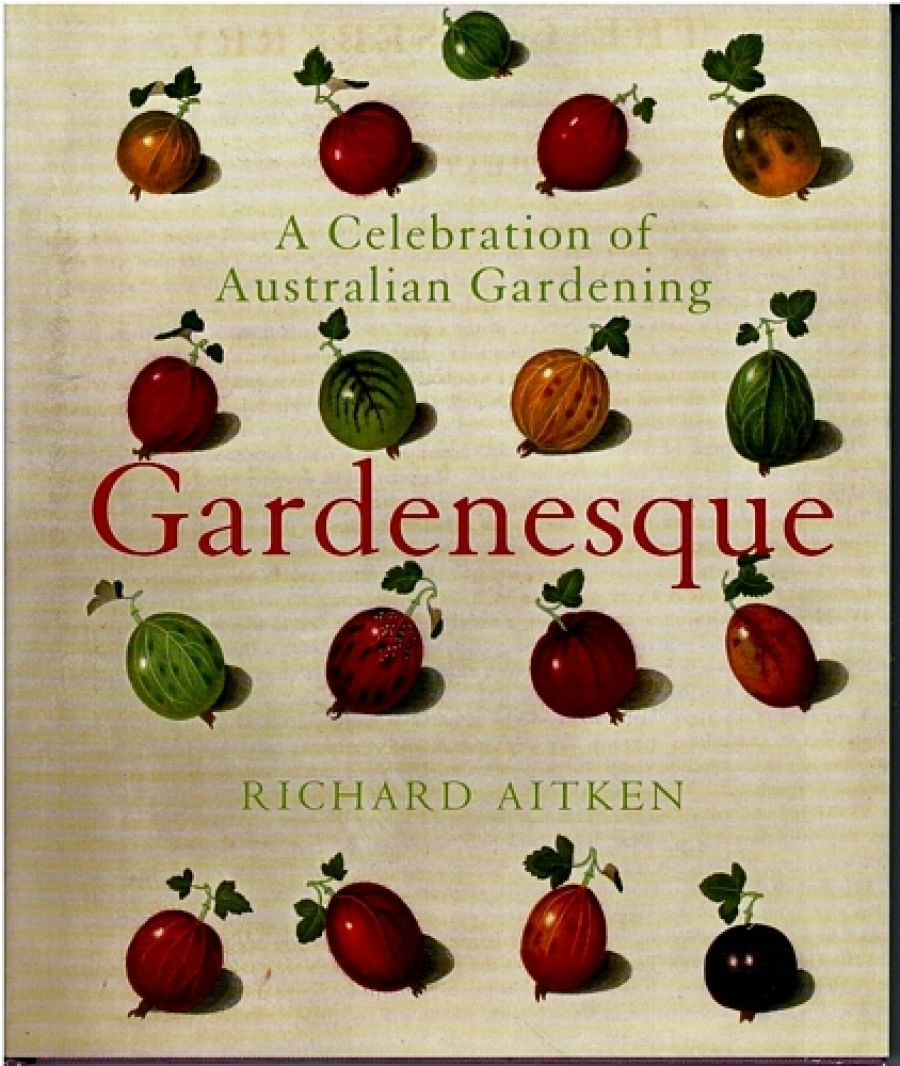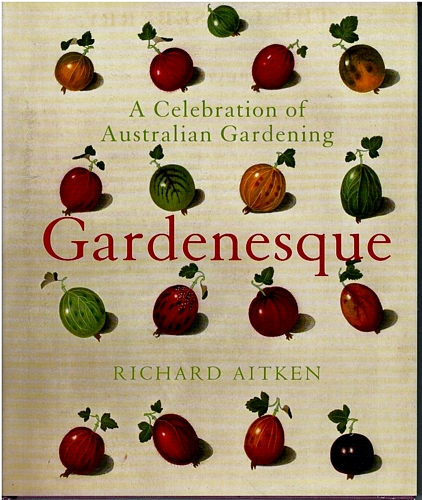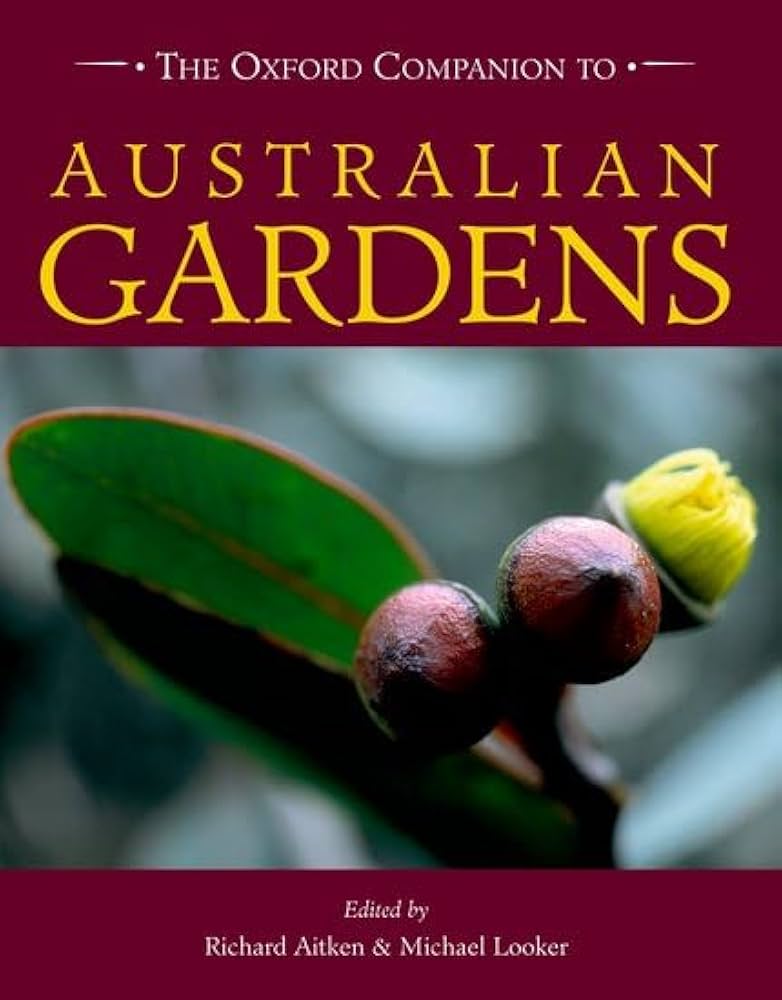
- Free Article: No
- Contents Category: Nature Writing
- Review Article: Yes
- Article Title: Beyond the Fence
- Online Only: No
- Custom Highlight Text:
Gardening is as old as the British settlement of Australia, but its popularity among the expanding middle classes has blossomed throughout the continent over the last forty years. The annual guide published by Australia’s Open Garden Scheme with the ABC, and Louise Earwaker and Neil Robertson’s The Open Garden (2000), attest to the variety of gardening styles practised today.
- Book 1 Title: Gardenesque
- Book 1 Subtitle: A celebration of Australian gardening
- Book 1 Biblio: Miegunyah Press, $45hb, 239pp
- Book 1 Cover Small (400 x 600):

- Book 1 Cover (800 x 1200):

- Book 2 Title: The Oxford Companion to Australian Gardens
- Book 2 Biblio: OUP, $120hb, 721 pp
- Book 2 Cover Small (400 x 600):

- Book 2 Cover (800 x 1200):

Its aim has been bold, its scope broad. The editors, Richard Aitken and Michael Looker, have, in their choice of the 1500 entries, rejected the traditional notion of a garden and ranged far beyond the fence. In doing so, they have distanced themselves from the book’s distinguished English predecessor, The Oxford Companion to Gardens (1986). Australian gardens in the six colonies and successor states embrace many schools and varieties of plants, design and scale, in land from semi-arid to subtropical, volcanic plain to mountains. The Australian Companion adopts a catholic and inclusive approach, confirmed in Gardenesque, where Aitken quotes with approval a landscape architect’s mocking rejection of the traditional definition.
Everything, however utilitarian, homely or kitsch, is included in the Companion. Echoing the post-1968 argument that popular culture is as worthy of study as high culture, Peter Watts rhetorically asks the reader: ‘Who is to say that a clipped box hedge has a higher purpose than a tyre swan’?’ (Edna Walling would have made a firm reply to this question.) The new thinking clears the ground for a social democratic approach to garden history, eschewing anything smacking of discrimination in its original sense. Such a position is easier to adopt in the absence of a modern general history of Australian gardening, and by default the Companion becomes a draft version of such a work; an enterprising writer could produce a general history by rearranging the alphabetical entries. The preface dismisses a linear interpretation of the development of Australian gardening, and the alphabetical entries, written by some 200 contributors, strengthen this dismissal and allow for a variety of voices and views.
Reading through the Companion and bearing in mind its pioneering status, one can comment only on general matters. The title, a misnomer, has been emptied of its old meaning to encompass the new understanding. The influence of landscape architecture is ubiquitous. The principal editor, Richard Aitken (architect and historian), has written some 226 entries and more than 300 captions to the illustrations – a formidable and influential contribution. A significant body of the other contributors comes from an architectural, historical or heritage background. The potential difference of viewpoint between the gardening and the architectural landscaping schools is revealed in the entry on ‘plant’, written by the co-editor, Michael Looker (botanist and director of the Trust for Nature): ‘To some, plants represent the essential component of gardening, while to others – often those fond of the term “plant material” – they are merely elements within an overall design scheme.’
The entries that stick closest to the Companion’s title cover historic gardens from the six colonies, biographies of gardeners, nurserymen and others from that world, and essay-length sketches of gardening in Australia, as well as definitions of garden styles and terms, such as ‘gardenesque’, Loudoun’s neologism, which Aitken further discusses in Gardenesque. It is interesting to compare the definition offered by the English Companion. The entries vary in substance, quality and reach, not to speak of accuracy (compare ‘lich-gate’ with the OED definition). Among the most effective are those such as ‘seasons’ and ‘garden’, written by T.R. Garnett, which rise, like the lark ascending, and are written from the perspective of a different culture and an earlier era.
Much useful information may be garnered by reading the Australian Companion in continuous sections as a general history, rather than hopping distractedly from entry to entry. Under entries for various countries, one learns how their traditions have influenced the development of Australian gardens. Inevitably, the question poses itself: would a narrower scope have yielded more substantial entries? An allied question concerns the general character of many modern companions, regarded as reference books. Are they compiled to provide brief answers to passing questions? With their mass of cross-references, do they merely represent an enclosed world? Or, like the Australian Dictionary of Biography, should they direct the reader to sources outside the boundaries of the volume?
To those addicted to reference books, there is a strong intertest in reading them as reflections of contemporary intellectual preoccupations. They become mirrors held up to an age. This may always have been the case, but it is more obvious now. The radical social history schools (so excoriated by Gertrude Himmelfarb) have exerted a powerful influence, both in the general framework of ideas among many of the contributors and in the choice of subjects. From gardens and parks, we proceed to tea and beer gardens, amusement parks and on to air-raid shelters and cemeteries. The studies of suburban living and leisure throw up many popular entries: barbecues, rotary hoists, letter boxes, caravan parks and swimming pools. The reader has travelled a long way from Edna Walling and herbaceous borders. For all the bent towards popular history, contributors can be as condescending as Vita Sackville-West: ‘variegation’ is placed ‘at the margins of conventional taste’. The postwar wine industry provides a substantial number of entries, while from a different perspective the worlds of planning and architecture introduce their disciplined views on the designed landscape. Whether unity is lost in the pursuit of catholicity is a consideration only the interested reader can decide.
Aboriginal Studies exert a powerful influence on the choice of entries and interpretation. Beth Gott puts the case for mainland Aborigines as gardeners, an argument rejected by Garnett, who states that there is no evidence that mainland Aborigines practised what the British understood by the subject. Of interest, the first illustration in Gardenesque is an 1843 squatter’s sketch of Aboriginal women gathering food-stuff. The implication is that this depicts a form of gardening. Strangely, the gardening practices of the Torres Strait Islanders (part of the Pacific tradition of cultivation) do not appear to receive a separate entry. As a post-Mabo work, the Companion employs appropriate vocabulary and postmodern punctuation to declare its position and signal its unease: e.g. occupation, invasion or ‘settlement’ of Australia.
Unease worms its way into a number of entries. Some contributors seem to find it difficult to use the straightforward word ‘ownership’ when describing properties and gardens held for a number of generations by the one family (itself an unusual occurrence in the shifting world of pastoral possession). One senses that many heritage officials believe that a public body may best administer an historic house and garden. At times, a gap reveals itself between the essentially conservative character of heritage houses, gardens, properties and the families who own them, and the new wave of heritage scholars, with their fundamentally different cultural framework. (The editors do not appear to share these attitudes.) Paradox is piled on paradox when one reads that the publication of both the Companion and Gardenesque was made possible by the substantial donation of inherited money.
Private generosity has enabled the production of the Companion. One hopes that, with a second edition, equally generous donors will come forward to underwrite the extra pages needed, so that, wherever possible, sources can be provided. The editors inform us that lack of space and ‘the unenviable task of ensuring consistency across such a diverse range of topics’ precluded the citation of articles and unpublished material (presumably reports and theses, many compiled at the taxpayers’ expense). Perhaps the comment on consistency is an oblique reference to ‘the relative rawness of garden history as an accepted discipline’. Whatever the reason, it means that much work carried out over the last twenty years is still locked away from an interested general readership. A select bibliography, starting from Victor Crittenden’s 1986 work, would also be useful.
Gardenesque (a most suitable Christmas present) is at once an epitome of the Companion, its decorative appendage, and an exhibition catalogue of works drawn from the collections of the State Library of Victoria. The 200-odd illustrations, handsomely reproduced (appearing to better effect than on the exhibition walls), take up many of the themes in the Companion. The captions have a quirky quality also found in the larger volume (‘quirky’ gets an entry in the latter) – perhaps an attempt to save garden history from preciousness. Essays by Aitken, Anne Latreille and Paul Fox explore, among other matters, the republican garden (Barry Humphries, please note) and gardening as the work of memory. The example of grandmothers is lauded, an act of piety that could be extended to discuss the notion of a green homeland of the mind, recollected since 1788 by people exiled to another country.
The Australian landscape known to our grandparents is poignantly caught forever in the scene of unmade road, sagging fence and redgums with a haze in the background, photographed by Edna Walling, a world celebrated by writers as diverse as Rolf Boldrewood and Martin Boyd, a world largely lost to most Australians.


Comments powered by CComment